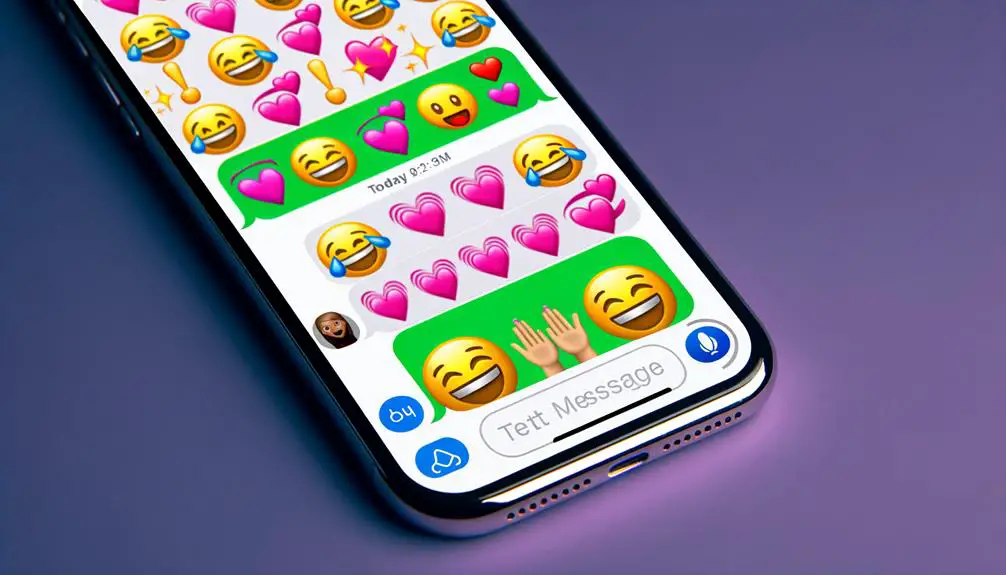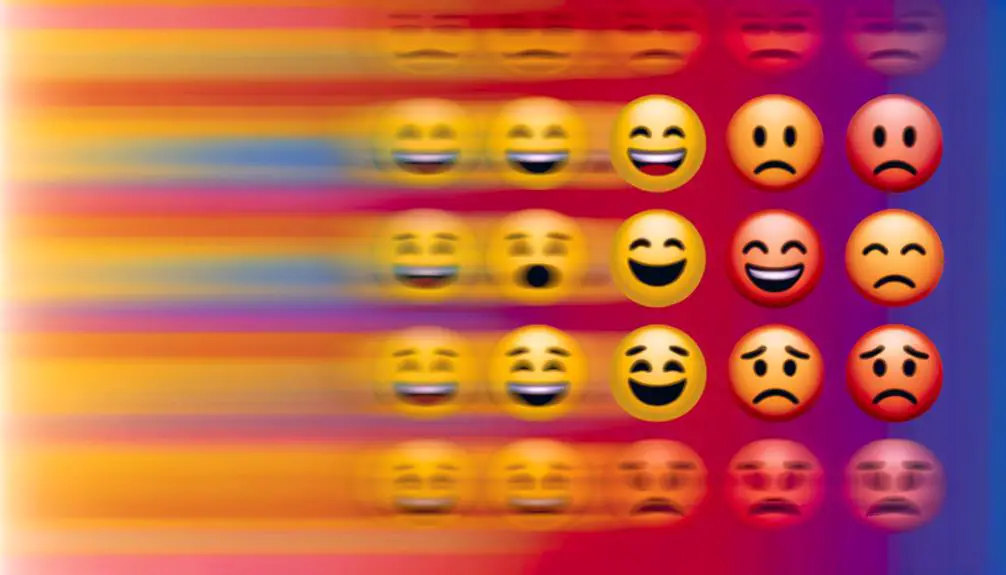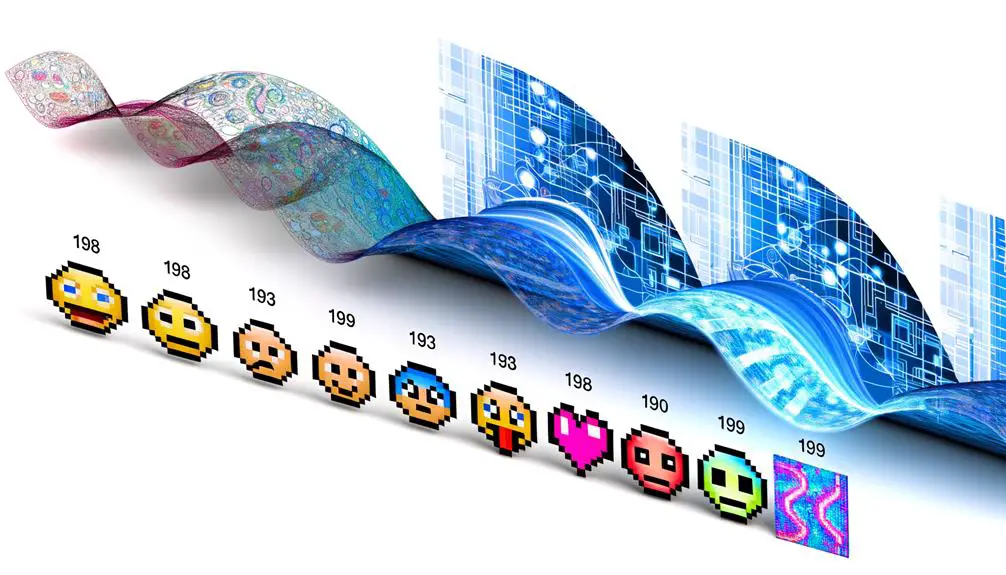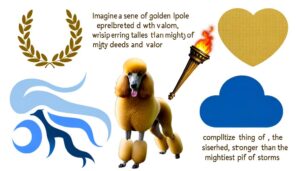Symbols Meaning in Text Messages
Understanding symbols in text messages is necessary for precise and effective communication. Common emojis like the thumbs up for approval and the heart for affection convey specific emotions and reactions, reducing ambiguity.
It is important to be aware of cultural differences—such as the thumbs-up gesture, which can be positive in Western contexts but offensive in others. Symbols also set the emotional tone, enhancing engagement and bridging cultural gaps.
In professional settings, judicious symbol use can complement messages while minimizing misinterpretation risks. Digital symbols have evolved from emoticons to GIFs, each adding layers of meaning.
To gain thorough insight, continue exploring.

Key Takeaways
- Emojis add emotional context to messages, reducing ambiguity.
- Thumbs-up emoji typically signifies approval or agreement.
- Heart emoji often represents affection, gratitude, or love.
- Cultural differences can affect the interpretation of symbols.
- Emojis enhance engagement and personalize communication.
Common Emoji Interpretations

Common emoji interpretations are vital for understanding the intended emotional tone and context in digital communication. Emojis serve as visual cues that supplement text, providing clarity and nuance to otherwise ambiguous messages.
For instance, the 'thumbs up' emoji universally signifies approval or agreement, streamlining communication. Similarly, the 'crying with laughter' emoji often indicates humor or amusement, effectively conveying emotional reactions.
However, emojis can carry multiple meanings depending on their context within a conversation. For example, the 'heart' emoji can represent affection, gratitude, or even platonic love. Recognizing these common interpretations is pivotal for deciphering the sender's intent accurately.
This understanding minimizes miscommunication, ensuring more effective and emotionally resonant digital interactions.
Cultural Differences in Symbols

Cultural differences greatly impact the interpretation and use of symbols in text messages, leading to variations in meaning and potential misunderstandings across diverse linguistic and social contexts. For instance, the thumbs-up emoji might be seen as a positive affirmation in Western cultures, whereas it could be interpreted as offensive in parts of the Middle East. Similarly, the folded hands emoji, often used to express gratitude in some cultures, may represent a prayer gesture in others.
| Symbol | Western Interpretation | Middle Eastern Interpretation |
|---|---|---|
| Thumbs-Up | Positive Affirmation | Offensive |
| Folded Hands | Gratitude | Prayer Gesture |
| OK Hand Sign | Okay/Good Job | Insult |
Understanding these cultural nuances is essential for effective cross-cultural communication in digital messaging.
Emojis and Emotional Tone

Emojis play a critical role in conveying emotional tone in text messages, serving as non-verbal cues that enhance or clarify the intended message. Their use allows for a nuanced expression beyond plain text, which can often be devoid of emotional context.
Various studies indicate that emojis assist in interpreting sentiment, reducing ambiguity, and fostering a sense of connection between communicators.
- Emotional Context: Emojis provide additional layers of meaning, making it easier to understand the sender's emotional state.
- Ambiguity Reduction: They help to clarify sarcastic or humorous remarks that might otherwise be misinterpreted.
- Engagement: Messages with emojis can feel more personal and engaging.
- Cultural Adaptation: Emojis can bridge cultural gaps by offering universally recognizable symbols.
Thus, incorporating emojis can greatly enhance the efficacy of digital communication.
Symbols in Professional Settings

In professional settings, the use of symbols and emojis must be carefully considered to maintain clarity and appropriateness in communication. Symbols can enhance the conveyance of information when used judiciously. However, their misuse can lead to ambiguity or perceived unprofessionalism. Below is a table delineating common symbols and their appropriate professional uses.
| Symbol | Appropriate Usage Example |
|---|---|
| ✔️ | Task completion confirmation |
| �� | Meeting or deadline reminder |
| �� | Highlighting important information |
| �� | Indicating positive growth or trends |
Understanding the context and audience is critical when integrating these symbols into professional correspondence. They should complement the message without overshadowing the content. Misinterpretation risks are minimized through clear, contextually relevant usage, ensuring effective and professional communication.
The Evolution of Digital Symbols

The historical development of digital symbols has greatly influenced how we communicate in both professional and personal contexts. Initially, symbols like emoticons and text-based shorthand emerged to convey tone and emotion, overcoming the limitations of plain text.
As technology advanced, these symbols evolved into sophisticated emojis and GIFs, providing richer layers of meaning and expression.
This evolution underscores the dynamic nature of digital communication, driven by technological progress and cultural shifts. Understanding this trajectory is essential for leveraging these symbols effectively in various communication scenarios.
- Emoticons: Early text-based symbols like :-) and :-(
- Emojis: Pictorial representations standardized across platforms
- GIFs: Animated images conveying complex emotions or reactions
- Stickers: Customizable images used in messaging apps
Conclusion
The interpretation of symbols in text messages is multifaceted, influenced by cultural contexts and the intended emotional tone. Understanding these nuances is essential for effective communication, particularly in professional settings.
For instance, a study conducted by the University of Edinburgh found that the use of the thumbs-up emoji in professional emails could be perceived as dismissive in some cultures, underscoring the importance of cultural awareness.
As digital symbols continue to evolve, their impact on communication dynamics warrants ongoing examination.





